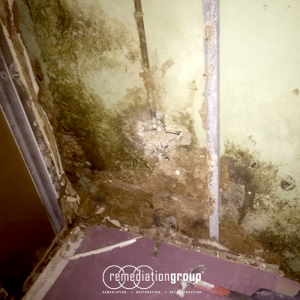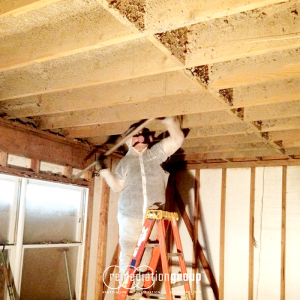Dry Ice Blasting
The Dry Ice Blasting Process ~ Source Removal is a new cleaning process that uses CO2 pellets (dry ice) for blast cleaning surfaces. It is similar to high-pressure washing, sand or glass bead blasting, but uses CO2 ice for more effective cleaning of biological matter like mold. It is a less messy procedure than water-based or sand-based blasting. With dry ice blasting, the pellets evaporate upon contact, leaving no residue or by-product. Due to environmental and production advantages, this method is quickly becoming the preferred cleaning method for industrial and specialty cleaning applications.
Summary of the Dry Ice Blasting Process
Mold remediation is a process not a chemical or treatment. True remediation removes mold spores instead of killing them. The intension is to remove the spores and their root system to protect against new infestation. REMEDIATION GROUP, INC. uses the state-of-the-art dry ice blasting process that has been proven to be superior to traditional methods like sanding, scraping and wire brushing. These methods often leave traces of mold spores in the wood grain and in areas difficult to reach. For this reason, REMEDIATION GROUP, INC. recommends dry ice blasting.
- Dry Ice Blasting
- Dry Ice Blasting Applications
- Mold Remediation
- Smoke Damage Restoration
- Paint Removal
- Historical Restoration
- Robotic Equipment
- Processing Equipment
- Manufacturing Equipment
- Sub-Stations
- Conveyors
- Tanks
- Printing Presses
- Boiler Tubes
- Aircraft
The Mold Remediation Process
- Construction of Critical Containment Barriers
A containment barrier is plastic sheeting that is installed to close off a contaminated area from a clean area. Multiple barriers may be installed, depending on the degree of mold infestation. - Discarding of Contaminated Building Materials
The decision to remove and replace mold contaminated building materials is dependent on the composition of the infested material. Porous materials like drywall or particleboard are generally discarded, since mold contamination runs marbled throughout the compound. Semi-porous materials like wood framing made of plywood and 2 x 4 studs can generally be remediated. These materials are dry ice blasted to remove imbedded mold spores. Nonporous materials like granite and semi- or high-gloss painted trim can simply be decontaminated. Dry Ice Blasting is a very effective way to remove mold. - Dry Ice Blasting Contaminated Surfaces
CO2 (dry ice) pellets are shot at high velocity onto the infested surface to blast the mold from the surface. An advantage of this method is its ability to clean surfaces regardless of the surface shape.The pellet form of dry ice is used to etch the first and second layer of wood from the framing where mold spores and hyphae can hide. The ice pellets freeze the mold and the moisture in the surface wood. This makes the surface layer brittle and easier to break away from the surface being cleaned. Upon contact, the dry ice converts from solid form to a harmless gas, leaving no messy residue to clean up. The freezing process creates no airborne blasting powder that can carry mold spores to uncontaminated areas. After ice blasting, the surface is HEPA vacuumed to remove any contamination missed by the blasting procedure. As a third precaution, the HEPA-cleaned surface is then wiped down with detergent and anti-microbial solution. - Application of Clear Anti-microbial Sealant to Remediated Framing*
All clean wood surfaces are sealed with a clear anti-microbial sealant to protect the wood from future mold infestation. All surfaces treated by REMEDIATION GROUP, INC. carry a 3-year manufacturer’s warranty that guarantees mold will not grow back or attach itself to the treated surface. *RGI utilizes GA State licensed applicators to apply antimicrobial products as required by the GA Dept. of Agriculture - Post Remediation Testing
REMEDIATION GROUP, INC. and the EPA strongly recommend post remediation verification testing (also known as PRVT or clearance testing) immediately after the remediation process and before containment barriers are removed and new building materials are introduced to the remediated area. The purpose of this step is to assure that the remediation process has been successful. REMEDIATION GROUP, INC. can assist the property manager in locating certified third party environmentalists to perform this final step in remediation. REMEDIATION GROUP, INC. has compiled a network of qualified environmentalists to perform such testing. All post-remediation testing criteria are determined by third party environmentalists and not REMEDIATION GROUP, INC., in order to avoid conflict of interest and to assure the highest surety of successful removal of contamination. - Our Service Guarantee
REMEDIATION GROUP, INC. guarantees that our work will pass post remediation testing by third party environmentalists. If the PRVT lab results or visual inspection prove that remediation efforts have not been successful, REMEDIATION GROUP, INC. will service the area again free-of-charge until third party environmentalist criteria are met.
Dry Ice Blasting Machines
RGI carries a large inventory of High Velocity Dry Ice Blasting Machines to be used with various cleaning and remediation applications.
























